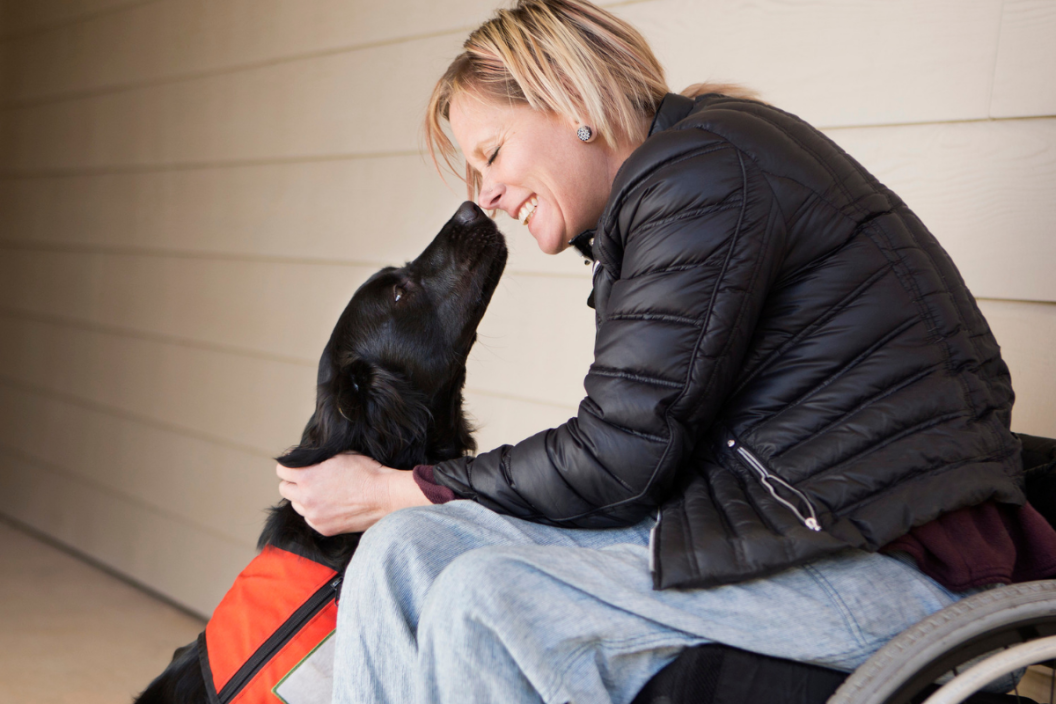Need an assistance dog? There are so many different service dogs ready to help!
People have many different needs, whether it be more an emotional support animal, a therapy dog, or a service dog. Dogs can be trained to help people with a wide variety of tasks and needs. Here's a look at the many different types of service dogs.
Service Dog Jobs
When most people think of service dogs, they immediately think of guide dogs — More specifically, seeing-eye dogs to help blind people with their day-to-day tasks. However, many different kinds of service dogs can help with particular tasks. Per the Americans with Disabilities Act, these dogs are trained and certified to work with people with disabilities. They are there to improve their quality of life and assist with their handler's specific disability, either at home or in public spaces.
The ADA says that disabilities can be any of the following:
- Physical
- Sensory
- Psychiatric
- Intellectual
- Mental Disability
Types of Service Dogs
https://www.instagram.com/p/CRmafK2L7SH/
Autism Service Dogs
According to Autism Speaks, autism support dogs can be a great help to children with autism. The pups are trained to the child's specific needs. They can help decrease the child's anxiety levels in unfamiliar situations and be a great icebreaker when meeting someone new or going somewhere for the first time.
Diabetic Alert Dogs
Dogs have an excellent sense of smell. Diabetic alert dogs are trained to monitor their partner's blood sugar levels. They will alert their owners when they detect that their glucose levels are dropping. Once alerted, the diabetic owner can take steps to course-correct before it is an emergency situation.
Allergy Detection Dogs
For those with severe allergies, it is vital for them to not come into contact with allergens that could trigger anaphylaxis. Some allergens that these dogs can detect are wheat, gluten, peanuts, eggs, and shellfish.
Post-Traumatic Stress Disorder
Since dogs are great for diffusing stress and providing emotional support, they can be beneficial during a PTSD episode. They help keep boundaries for their owner, including their personal space. The pups can also detect if their partner is having severe stress or flashbacks. Then, they will step in to assist.
Mobility Assistance Dogs
Pups in this service dog category help people who have a hard time getting around. For example, people with spinal cord injuries and other mobility-related impairments, like brain injuries.
According to K94Life, dog training covers ways to help people with mobility issues by picking up items that have been dropped, opening doors, or getting things that are out of reach.
These pups often wear a special harness to walk along next to a wheelchair or provide support to their human partners who may have strength and balance issues.
Hearing Dogs
Hearing dogs help their deaf owners by alerting them when there is a noise, like a knock at the door, alarm clock, or smoke alarms. Dogs with excellent hearing are usually trained for this task, which includes border collies and cocker spaniels.
Guide Dogs
Guide dogs help visually impaired people by guiding them as they walk, making sure they do not run into obstacles. The dogs are trained by programs like Guide Dogs, who train the pups to work with a visually impaired owner. Labrador Retrievers are often trained to be guide dogs. They have a sweet, calm temperament and are easy to train.
Seizure Response Dogs
Seizure alert dogs can detect oncoming seizures in their owners, especially those with epilepsy. According to the Epilepsy Foundation, the dogs learn to respond to a seizure. They can alert caregivers, hit an alarm, or move to protect the person having the seizure. Often, they make sure the person having a seizure is not injured.
Psychiatric Service Dogs
Psychiatric dogs can detect a psychiatric episode before it happens addition. In addition, the dogs are trained to help comfort their owner and lessen the overall effects of the episode.
Emotional Support Dogs
https://www.instagram.com/p/Bhwz09Ihh0r/
RELATED: Traveling With Service Dogs? Tips for Flying, Driving, and More
Emotional support dogs or ESAs can be helpful for their human's mental health. However, these dogs aren't necessarily trained with tasks in mind. Instead, training focuses on bonding with their owner to provide adequate support during a psychiatric episode.
Areas these dogs can help are with things like:
- Anxiety
- Depression
- Panic attacks
- Certain phobias
- Loneliness
However, many people claim emotional support dogs when they are not actually certified. For dogs to be official emotional support dogs, their owners need to have a prescription for the dog from a mental health professional for an emotional or psychological disorder.
Reasonable accommodations need to be made for those who want the pets to be in their homes. However, airlines are no longer required to allow ESAs onboard.
Therapy Dogs
https://www.instagram.com/p/CRobb1AhmJu/
Therapy dogs have a different role than other service dogs. They are not trained to work with a specific person. Instead, training prepares them to help multiple groups of people. Many dog breeds can be used as therapy dogs, from Golden Retrievers to German Shepherds and even Poodles.
Therapy dogs help people that are in places such as:
- Hospitals
- Mental health institutes
- Hospice
- Schools
- Nursing homes
Therapy dogs also offer support to people in tragedy and can be valuable in helping people release stress. However, therapy dogs are not officially recognized as service dogs under the ADA and do not have the same rights. Stores are not required to let them in, nor are they required to be allowed with their owners on airplanes.
However, you should always train your therapy dog and have them insured and licensed.
Man's best friend can do many tasks for people with disabilities, making all types of service dogs important. Still, it is essential to remember that these service animals are working dogs, not just pets, especially when you see them in public places.
For more, follow our Wide Open Pets Facebook page!




